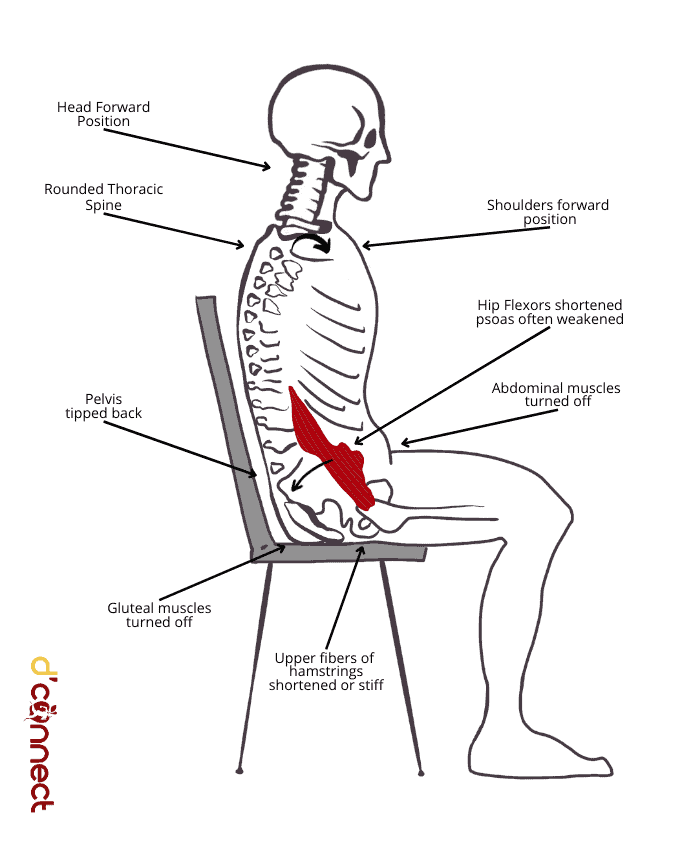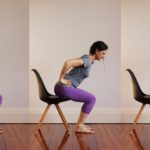
Kim Hoffmann
NASM CES (Corrective Exercise Specialist) and Certified Personal Trainer
Like any muscle, the glutes can also be underdeveloped. This can cause problems in the areas above or below the hip-pelvic region.
Because our society is becoming more sedentary, it is very common for our glutes to be weak. Some problems that can occur from weak or underdeveloped glutes are:
- Lower crossed syndrome
- Low back pain
- Knee or hip pain
- Abnormal gait or walking pattern
Before we start with getting our glutes back in shape, it’s important to be aware of certain issues to prevent potential injuries.
Lower Crossed Syndrome
Lower crossed syndrome is where certain muscles of the hip-pelvic region are too tight, while others are too weak. This creates an imbalance.
Such an imbalance can pull our pelvis forward (anterior pelvic tilt) or backward (posterior pelvic tilt) depending on which muscles are doing the pulling.
For example, in the case of someone who sits a lot at their desk, they will have their legs and hips bent for the majority of the day. This puts the hips and knees in flexion, which means the hips flexors (Iliacus and Psoas Major) are constantly pulled into a shortened position.
Glutes are the hip extensors of our body and if they are too weak or underused to offer resistance to the hip flexors, these muscles will pull at the pelvis.
This can ultimately create problems in the hip-pelvic region or in the lower back.

Low back pain
This is a very broad subject and there could be other reasons as to why we may experience low back pain. However, we will briefly go over some of the possible reasons.
One of these relates to lower crossed syndrome we mentioned earlier. If the pelvis gets pulled forward due to tight hip flexors, there is extra pressure on the vertebrae of the lumbar spine.
If the pressure becomes too much, the disc can push out and cause a condition called bulging disc, which can lead to herniated, or slipped, disc.
This is usually only painful when the disc presses on the nerves. Most people have some form of bulging or herniated disc because of our lifestyle. This can also be a usual result from aging.
Weak glutes may cause sciatica
The sciatic nerve starts in the lumbar spine and when a tilted pelvis puts extra pressure on the vertebrae of the lower back, this can cause a herniated disc to press onto the sciatic nerve.
This might explain the pain, tingling or numbness down your leg.
Knee pain
If the glutes are weak, the hamstrings will have to take over. This means that the quadriceps on the opposite side need to work harder as well to counter the pressure that’s being put on the knee.
If the quadriceps are also not strong enough to offer resistance to the hamstrings, there will be extra pressure on the knee, which can cause pain.
Abnormal gait or walking
In a good scenario, every time we take a step, our gluteus maximus will fire, because this is hip extension. In an ideal scenario, the gluteus medius and minimus will also work because when we lift our leg to take that step, our hips need to be kept level.
If our gluteus medius and minimus are not strong enough, they will not be able to hold up the hip when we take that step.
This can create a condition called Trendelenburg Gait. This means our hips drop on the leg that’s lifted.
Beside postural improvement and injury and pain prevention, gluteus training is important to advance in our general training. Because glutes are the hip extensors, whenever we stand up from a squat or deadlift, we use our glutes.
Stronger glutes means stronger squat or deadlift, and as we advance in age that means that having strong glutes can also prevent falls.
RELATED — Exercise Guide to: Glorious Glutes
Related Questions
1. What are common signs of weak glutes?
One of the first signs to notice is low back pain. Other signs could be poor posture or pain in knees and/or hips.
2. How long does it take to strengthen the glutes?
As with all muscles it will take a few weeks to notice a difference, but it all depends on how often and what kind of training we do.
3. Does squeezing my glutes while sitting counts as exercise?
Not really. The whole point of exercise is to gradually increase the load, no matter our goal. By only squeezing glutes we don’t put a lot of stress on the muscles.
4. What is deep gluteal syndrome?
It’s sort of an umbrella term for other conditions like Piriformis Syndrome, Gluteal Tendinopathy, Sacroiliac Joint Dysfunction and more.[1]
Symptoms usually include pain and/or numbness in the buttock, hip or posterior thigh with pain radiating down the leg.
5. What is superior gluteal nerve compression?
This is a compression or entrapment of the superior part of the sciatica nerve and is often confused with Piriformis Syndrome.[2]
It presents like sciatica pain, but is often caused by inflammation of different gluteal muscles and traps the nerve between the hip bones and the muscles.
Kim Hoffmann is a certified Personal Trainer and Corrective Exercise Specialist based in Auckland. She also specialises in women’s health and fitness by taking into consideration the menstrual cycle and hormones and implementing them in different workout plans. The workout methods and routines include free weights, suspension straps and boxing, as well as strength training and high intensity.
Kim’s passion is helping people move better and improve their quality of life. She helps men and women of all ages achieve their goals and also offers online classes and consultations. You can see more of Kim at Snatch Fitness.
References
(1) Physiopedia. Deep Gluteal Pain Syndrome. Retrieved from https://www.physio-pedia.com/Deep_Gluteal_Pain_Syndrome
(2) C.E.S.physioRehab. (2021). Superior Gluteal Nerve Entrapment. Retrieved from https://www.cesphysiorehab.com/post/superior-gluteal-nerve-entrapment






